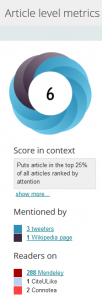This month I had the good fortune to attend the inaugural Advancing Research Communication and Scholarship meeting here in Philadelphia. The best panels brought together researchers, publishers, service providers and librarians with contrasting, yet complementary perspectives on how best to communicate and share scholarship.
As an assessment librarian looking at ways of demonstrating the impact of scholarship, I was particularly excited by the conversations surrounding “altmetrics” – alternative assessment metrics. Coined by Jason Priem in 2010, the term describes metrics that are not traditional citation counts or impact factors – altmetrics counts “attention” on social media like Twitter. Conference participants debated the limitations and value of these new measures for understanding impact as well as exploring their use for scholarly networking or tracking use of non-traditional research outputs like data sets and software.
Todd Carpenter (National Institute for Standards Organization) reported on the NISO initiative to draft standards for alternative metrics. Carpenter points out that altmetrics will not replace traditional methods for assessing impact, but he asks, “Would a researcher focus on only one data source or methodological approach?” In measuring impact of different formats, we need to insure that everyone is counting things in the same way. The initiatives first data gathering phase has resulted in a whitepaper synthesizing hundreds of stakeholder comments, and will suggest potential next steps in developing a more standardized approach to alternative measurements. For more information about the initiative and to review the whitepaper, visit the Project Site at: http://www.niso.org/topics/tl/altmetrics_initiative/
SUNY Stony Brook’s School of Medicine has been very aggressive in its approach to making researcher activity and impact visible. Andrew White (Associate CIO for Health Sciences, Senior Director for Research Computing) spoke about the School’s use of altmetrics in building a faculty “scorecard, ” standardized profiles showing education, publications and grants activity. White sees altmetrics as a way of contributing to these faculty profiles, providing evidence of impact in areas not anticipated, like citations in policy documents. Through altmetrics they’ve unearthed additional media coverage (perhaps in the popular press) as well as evidence for the global reach of their faculty and clinicians.
Stefano Tonzani (Manager of Open Access Business Development at John Wiley) provided us with a publisher’s perspective. Wiley has embedded altmetrics data into 1600 of their online journals.  This can be a marketing tool for editors, who “get to know their readership one by one” as well as attracting authors, who like to know who is reading, and tweeting about, their research. Tonzani suggests that authors use altmetrics to discover and network with researchers interested in their work, or more deeply understand how their paper influences the scientific community.
This can be a marketing tool for editors, who “get to know their readership one by one” as well as attracting authors, who like to know who is reading, and tweeting about, their research. Tonzani suggests that authors use altmetrics to discover and network with researchers interested in their work, or more deeply understand how their paper influences the scientific community.
On the other hand, according to the NISO research, only 5% of authors even know about altmetrics! As librarians, we have a good deal to do in educating faculty and students about developing and attending to their online presence towards broadening the reach of their scholarly communication.
